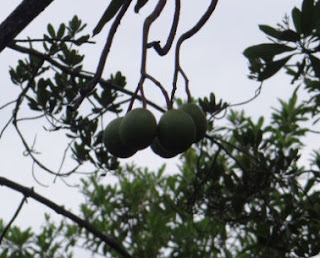In Bintan Islands

Today afternoon I arrived here in Bintan Islands (957 sq kms area) in the Riau archipelago of Indonesia which is just a hour-long ferry ride from Singapore across the Singapore Strait. A motorized catamaran takes even less.
Bintan is the largest of the 3200 islands in Riau and Indonesia is promoting Bintan as the next popular international destination after Bali islands. Bintan has beaches and beach-front; International hotels and resorts; the most prominent of these beaches is the Bintan Resorts spread over 300 hectares of tropical environment. The capital city Tanjung Pinang is an autonomous area within the island.
Bintan’s history is traced to the early 3rd century. The island flourished as a trading post on the route between China and India. It came under the control of the Chinese, British and the Dutch. It was declared a part of the Dutch East Indies through the Anglo-Dutch Treaty of 1824. In the 12th century, the Bintan Island in the Strait of Malacca was known as the “Pirate Island” since the Malay pirates used to loot trading ships sailing in these waters A great thing about landing in Bintan is that Indian passport holder gets Visa on arrival without any hassles. In fact, if you are travelling Emerald Class in the ferry (read business class) it is so convenient that all the formalities at the emigration centre is taken care of and you get your passport stamped and back while having a drink at the lounge. From there you can proceed to the ferry directly.

In fact, one, with this class, you get a golf car service from the ferry gate to the arrival lounge. After arriving in Bintan I checked in at a tropical retreat called the Banyan Tree Bintan (picture)
with its collection of Balinese-inspired villas nestled in the lush foliage of tropical rain forests above a secluded bay in the northwestern tip of the island overlooking the South China Sea. The tropical scenery of Tanjong Said Bay greets visitors upon arrival. I had lunch at one of the restaurants of the Banyan Tree Bintan called The Cove. It turned out to be a contemporary Mediterranean style outlet, which opens for lunch and dinner, offering a wide variety of pizzas, pastas and specialty drinks. Initially, my booking was at the Lotus Restaurant in Bintan just next door property owned by the same group. I, however, was mesmerized by the panoramic view from The Cove and decided to have lunch there only.

Frankly, I was expecting a very different menu at The Cove as it was Mediterranean restaurant. But there were pastas to choose from which was good for veggie like me.
After a sumptuous late lunch at The Cove I hired a private boat and set out for a river ride amid mangrove forests. After about an hour’s ride on the Sebung River I was back in nature’s lap; soaking in the amazing beauty of the mangroves. This was very green and very different from my last major outings i.e., the forests of Ranthambore in Rajasthan and before that the Himalayan foothill forests of Bhutan. Indeed, Mother nature presents itself to us in such different yet amazing ways.
The Sebung river waterways are about only 5 feet deep in many stretches. I decided to take a little risk and go inside the river lanes into the heart of the mangrove forests. Mangroves have four kinds of roots, ribbon roots, knee roots, stilt roots and the pencil roots that are visible during the low tide. Mangrove forests are also home to very poisonous species of snakes that sleep on the trees during day time but are up and on after dusk. The shadows were lengthening and I returned to the main river.
While in the mangrove my boatman barked and alert and I saw a big snake coiled in its sleep on a tree. In the main river, the water was about 12 to 15 feet deep but navigation was difficult due to the artery-like narrow lanes.

I had my anxious moments when the boatman crossed the trees’ branches overhead on which the snakes – I like to believe – were perched asleep (picture).

Naturally, the fear of what would happen if the snake fell on the boat crossed my mind a million times in those few seconds we passed under.
Sensing my discomfiture, the boatman assured me that there was still time before the snake woke up. The mangrove is home to seven or eight species of snakes which are very common.

This includes pythons and yellow banded snakes. In the mangroves I spotted five snakes one of which was a cobra. I also a two feet monitor lizard (picture) that seemed camouflaged against the tree. I am told there are ones up to four feet or more from head to tail.

I also saw fruits on the trees all around and my boatman told me that these were highly poisonous and a single bite of the fruit could kill a person (picture).
The river ride down Sebung at night is yet another life time experience with the highlight of the tour being the sighting of the thousands and thousands of fireflies (lightning bugs) and their sporadic movements and luminescence that make the mangroves seem like thousands of Christmas trees with twinkling lights.
I was little shaken by the the snake on the tree above and can only try and visualize the beauty of the groves at night. May be someday I’d have the heart to sail down Sebung at night.
The mangrove trip was really very enchanting and magical.
ess bee
